
Concept explainers
(a)
Interpretation: The explanation corresponding to the incorrect IUPAC name
Concept introduction: The systematic naming of organic compound is given by
Rules for writing structural formula from IUPAC are:
1. First identify the word root for the given compound.
2. The suffix used in the compound like –ene.
3. Identify the position, location, and number of the substituent bonded to the carbon chain.
Answer to Problem 4.41P
The naming of substituents attached to the longest carbon chain is not in alphabetical order. The correct IUPAC name is
Explanation of Solution
The given IUPAC name is
The structure corresponding to the given IUPAC name is shown below.

Figure 1
Rules for writing IUPAC name from structural formula are:
1. First identify the longest carbon chain.
2. The next step is to identify the groups attached to the longest chain.
3. Identify the position, location, and number of the substituent bonded to the carbon chain.
4. Use prefix di, tri, tetra if same type of substituent is present.
5. Name the substituents in alphabetical order.
The given name is
The naming of substituents attached to the longest carbon chain is not in alphabetical order. The correct IUPAC name is
(b)
Interpretation: The explanation corresponding to the incorrect IUPAC name
Concept introduction: The systematic naming of organic compound is given by IUPAC nomenclature. The naming of organic compound is done such that the structure of organic compound is correctly interpreted from the name.
Rules for writing structural formula from IUPAC are:
1. First identify the word root for the given compound.
2. The suffix used in the compound like –ene.
3. Identify the position, location, and number of the substituent bonded to the carbon chain.
Answer to Problem 4.41P
The longest carbon chain in the given IUPAC name contains seven carbon atoms instead of six carbon atoms. The correct IUPAC name is
Explanation of Solution
The given IUPAC name is
The structure corresponding to the given IUPAC name is shown below.
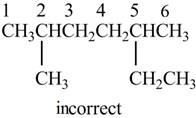
Figure 2
According to the given IUPAC name, the structure contains six carbon atoms.
Rules for writing IUPAC name from structural formula are:
1. First identify the longest carbon chain.
2. The next step is to identify the groups attached to the longest chain.
3. Identify the position, location, and number of the substituent bonded to the carbon chain.
4. Use prefix di, tri, tetra if same type of substituent is present.
5. Name the substituents in alphabetical order.
Thus, the correct structure for the given name is shown below.
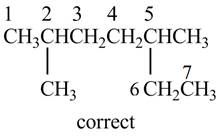
Figure 3
The longest carbon chain in the given IUPAC name contains seven carbon atoms instead of six carbon atoms. Thus, the correct IUPAC name is
The longest carbon chain in the given IUPAC name contains seven carbon atoms instead of six carbon atoms., the correct IUPAC name is
(c)
Interpretation: The explanation corresponding to the given incorrect IUPAC name
Concept introduction: The systematic naming of organic compound is given by IUPAC nomenclature. The naming of organic compound is done such that the structure of organic compound is correctly interpreted from the name.
Rules for writing structural formula from IUPAC are:
1. First identify the word root for the given compound.
2. The suffix used in the compound like –ene.
3. Identify the position, location, and number of the substituent bonded to the carbon chain.
Answer to Problem 4.41P
The longest carbon chain in the given IUPAC name contains eight carbon atoms instead of seven carbon atoms. The correct IUPAC name is
Explanation of Solution
The given IUPAC name is
The structure corresponding to the given IUPAC name is shown below.
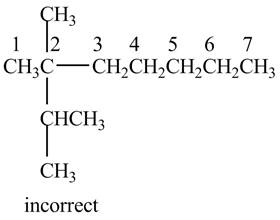
Figure 4
According to the given IUPAC name, the structure contains seven carbon atoms.
Rules for writing IUPAC name from structural formula are:
1. First identify the longest carbon chain.
2. The next step is to identify the groups attached to the longest chain.
3. Identify the position, location, and number of the substituent bonded to the carbon chain.
4. Use prefix di, tri, tetra if same type of substituent is present.
5. Name the substituents in alphabetical order.
Thus, the correct structure for the given name is shown below.
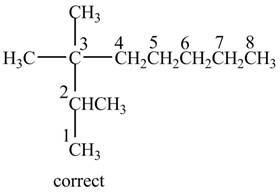
Figure 5
The longest carbon chain in the given IUPAC name contains eight carbon atoms instead of seven carbon atoms. Therefore, the correct IUPAC name is
The longest carbon chain in the given IUPAC name contains eight carbon atoms instead of seven carbon atoms. The correct IUPAC name is
(d)
Interpretation: The explanation corresponding to the given incorrect IUPAC name
Concept introduction: The systematic naming of organic compound is given by IUPAC nomenclature. The naming of organic compound is done such that the structure of organic compound is correctly interpreted from the name.
Rules for writing structural formula from IUPAC are:
1. First identify the word root for the given compound.
2. The suffix used in the compound like –ene.
3. Identify the position, location, and number of the substituent bonded to the carbon chain.
Answer to Problem 4.41P
The structure corresponding to the given name is incorrect because the numbering of substituents is wrong. The correct IUPAC name is
Explanation of Solution
The given IUPAC name is
The structure corresponding to the given IUPAC name is shown below.
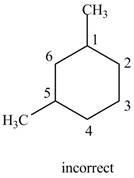
Figure 6
Rules for writing IUPAC name from structural formula are:
1. First identify the longest carbon chain.
2. The next step is to identify the groups attached to the longest chain.
3. Identify the position, location, and number of the substituent bonded to the carbon chain.
4. Use prefix di, tri, tetra if same type of substituent is present.
5. Name the substituents in alphabetical order.
The given name is
The structure corresponding to the given name is incorrect because higher number is assigned to the second methyl substituent.
Therefore, the correct structure is shown below.
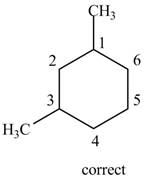
Figure 7
Thus, the correct IUPAC name is
The structure corresponding to the given name is incorrect because higher number is assigned to the second substituent. The correct IUPAC name is
(e)
Interpretation: The explanation corresponding to the incorrect IUPAC name
Concept introduction: The systematic naming of organic compound is given by IUPAC nomenclature. The naming of organic compound is done such that the structure of organic compound is correctly interpreted from the name.
Rules for writing structural formula from IUPAC are:
1. First identify the word root for the given compound.
2. The suffix used in the compound like –ene.
3. Identify the position, location, and number of the substituent bonded to the carbon chain.
Answer to Problem 4.41P
The structure corresponding to the given name is incorrect because higher number is assigned to the second substituent. The correct IUPAC name is
Explanation of Solution
The given IUPAC name is
The structure corresponding to the given IUPAC name is shown below.
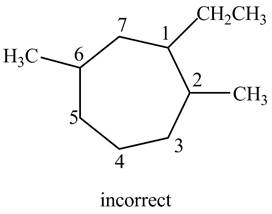
Figure 8
Rules for writing IUPAC name from structural formula are:
1. First identify the longest carbon chain.
2. The next step is to identify the groups attached to the longest chain.
3. Identify the position, location, and number of the substituent bonded to the carbon chain.
4. Use prefix di, tri, tetra if same type of substituent is present.
5. Name the substituents in alphabetical order.
The given name is
The structure corresponding to the given name is incorrect because higher number is assigned to the second substituent.
Therefore, the correct structure is shown below.

Figure 9
Thus, the correct IUPAC name is
The structure corresponding to the given name is incorrect because higher number is assigned to the second substituent. The correct IUPAC name is
(f)
Interpretation: The explanation corresponding to the incorrect IUPAC name
Concept introduction: The systematic naming of organic compound is given by IUPAC nomenclature. The naming of organic compound is done such that the structure of organic compound is correctly interpreted from the name.
Rules for writing structural formula from IUPAC are:
1. First identify the word root for the given compound.
2. The suffix used in the compound like –ene.
3. Identify the position, location, and number of the substituent bonded to the carbon chain.
Answer to Problem 4.41P
The structure corresponding to the given name is incorrect because the numbering of substituents is wrong. The correct IUPAC name is
Explanation of Solution
The given IUPAC name is
The structure corresponding to the given IUPAC name is shown below.
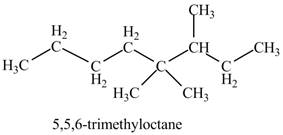
Figure 10
Rules for writing IUPAC name from structural formula are:
1. First identify the longest carbon chain.
2. The next step is to identify the groups attached to the longest chain.
3. Identify the position, location, and number of the substituent bonded to the carbon chain.
4. Use prefix di, tri, tetra if same type of substituent is present.
5. Name the substituents in alphabetical order.
The given name is
The structure corresponding to the given name is incorrect because substituents should get lowest locant number.
Therefore, the correct structure is shown below.
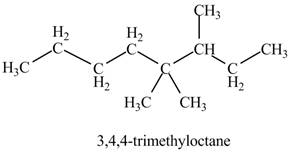
Figure 11
Thus, the correct IUPAC name is
The structure corresponding to the given name is incorrect because higher number is assigned to the second substituent. The correct IUPAC name is
(g)
Interpretation: The explanation corresponding to the incorrect IUPAC name
Concept introduction: The systematic naming of organic compound is given by IUPAC nomenclature. The naming of organic compound is done such that the structure of organic compound is correctly interpreted from the name.
Rules for writing structural formula from IUPAC are:
1. First identify the word root for the given compound.
2. The suffix used in the compound like –ene.
3. Identify the position, location, and number of the substituent bonded to the carbon chain.
Answer to Problem 4.41P
The structure corresponding to the given name is incorrect because the numbering of substituents is wrong. The correct IUPAC name is
Explanation of Solution
The given IUPAC name is
The structure corresponding to the given IUPAC name is shown below.

Figure 12
Rules for writing IUPAC name from structural formula are:
1. First identify the longest carbon chain.
2. The next step is to identify the groups attached to the longest chain.
3. Identify the position, location, and number of the substituent bonded to the carbon chain.
4. Use prefix di, tri, tetra if same type of substituent is present.
5. Name the substituents in alphabetical order.
The given name is
Therefore, the correct structure is shown below.
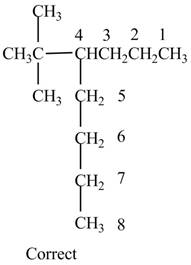
Figure 13
Thus, the correct IUPAC name is
The structure corresponding to the given name is incorrect because higher number is assigned to the second substituent. The correct IUPAC name is
(h)
Interpretation: The explanation corresponding to the incorrect IUPAC name
Concept introduction: The systematic naming of organic compound is given by IUPAC nomenclature. The naming of organic compound is done such that the structure of organic compound is correctly interpreted from the name.
Rules for writing structural formula from IUPAC are:
4. First identify the word root for the given compound.
5. The suffix used in the compound like –ene.
6. Identify the position, location, and number of the substituent bonded to the carbon chain.
Answer to Problem 4.41P
The structure corresponding to the given name is incorrect because higher number is assigned to the second substituent. The correct IUPAC name is
Explanation of Solution
The given IUPAC name is
The structure corresponding to the given IUPAC name is shown below.
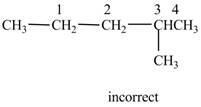
Figure 14
Rules for writing IUPAC name from structural formula are:
1. First identify the longest carbon chain.
2. The next step is to identify the groups attached to the longest chain.
3. Identify the position, location, and number of the substituent bonded to the carbon chain.
4. Use prefix di, tri, tetra if same type of substituent is present.
5. Name the substituents in alphabetical order.
The given name is
Therefore, the correct structure is shown below.
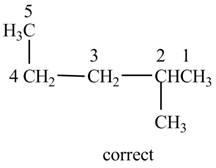
Figure 15
The longest carbon chain contains five carbon atoms instead of four carbon atoms.
Thus, the correct IUPAC name is
The structure corresponding to the given name is incorrect because higher number is assigned to the second substituent. The correct IUPAC name is
Want to see more full solutions like this?
Chapter 4 Solutions
ORGANIC CHEMISTRY
- Provide the semi-developed formula of isooxazole obtained by reacting acetylacetone and hydroxylamine.arrow_forwardGiven a 1,3-dicarbonyl compound (R1-CO-CH2-CO-R2), indicate the formula of the compound obtaineda) if I add hydroxylamine (NH2OH) to give an isooxazole.b) if I add thiosemicarbazide (NH2-CO-NH-NH2) to give an isothiazole.arrow_forwardAn orange laser has a wavelength of 610 nm. What is the energy of this light?arrow_forward
- The molar absorptivity of a protein in water at 280 nm can be estimated within ~5-10% from its content of the amino acids tyrosine and tryptophan and from the number of disulfide linkages (R-S-S-R) between cysteine residues: Ε280 nm (M-1 cm-1) ≈ 5500 nTrp + 1490 nTyr + 125 nS-S where nTrp is the number of tryptophans, nTyr is the number of tyrosines, and nS-S is the number of disulfide linkages. The protein human serum transferrin has 678 amino acids including 8 tryptophans, 26 tyrosines, and 19 disulfide linkages. The molecular mass of the most dominant for is 79550. Predict the molar absorptivity of transferrin. Predict the absorbance of a solution that’s 1.000 g/L transferrin in a 1.000-cm-pathlength cuvet. Estimate the g/L of a transferrin solution with an absorbance of 1.50 at 280 nm.arrow_forwardIn GC, what order will the following molecules elute from the column? CH3OCH3, CH3CH2OH, C3H8, C4H10arrow_forwardBeer’s Law is A = εbc, where A is absorbance, ε is the molar absorptivity (which is specific to the compound and wavelength in the measurement), and c is concentration. The absorbance of a 2.31 × 10-5 M solution of a compound is 0.822 at a wavelength of 266 nm in a 1.00-cm cell. Calculate the molar absorptivity at 266 nm.arrow_forward
- How to calculate % of unknown solution using line of best fit y=0.1227x + 0.0292 (y=2.244)arrow_forwardGiven a 1,3-dicarbonyl compound, state the (condensed) formula of the compound obtaineda) if I add hydroxylamine (NH2OH) to give an isooxazole.b) if I add thiosemicarbazide (NH2-CO-NH-NH2) to give an isothiazole.arrow_forwardComplete the following acid-base reactions and predict the direction of equilibrium for each. Justify your prediction by citing pK values for the acid and conjugate acid in each equilibrium. (a) (b) NHs (c) O₂N NH NH OH H₁PO₁arrow_forward
- 23.34 Show how to convert each starting material into isobutylamine in good yield. ཅ ནད ཀྱི (b) Br OEt (c) (d) (e) (f) Harrow_forwardPlease help me Please use https://app.molview.com/ to draw this. I tried, but I couldn't figure out how to do it.arrow_forwardPropose a synthesis of 1-butanamine from the following: (a) a chloroalkane of three carbons (b) a chloroalkane of four carbonsarrow_forward
 Chemistry: An Atoms First ApproachChemistryISBN:9781305079243Author:Steven S. Zumdahl, Susan A. ZumdahlPublisher:Cengage Learning
Chemistry: An Atoms First ApproachChemistryISBN:9781305079243Author:Steven S. Zumdahl, Susan A. ZumdahlPublisher:Cengage Learning
